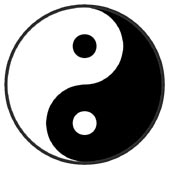Thinking about the Unthink-About-Able
[This essay was originally posted to YouAreThat.org.]
The Condensed Version
The word "God" denotes a notoriously slippery concept. (In fact, in my thinking, the idea has no denotation; it's all connotation, like the word "Love.") In this somewhat-ironically named essay I examine some of the ways of thinking about God.
Almost every page of Realize! centers around a concept of "God," whether God is actually mentioned or not. So it might be useful to the reader to know what that word means to me.
First, let me tell you that you may be disappointed; I'm not going to explain God to you. At best, I may end up telling you what God isn't.
God With Attributes and God Without
A handy way to talk about God is to use some of the categories used in traditional discussions of God. One of these, a well-known dichotomy in India, is the idea of God with Attributes and God without Attributes. The idea is simple. There are many gods in India, with many attributes: male vs. female, beautiful vs. hideous, benevolent vs. destructive, and so on. But it is widely understood that behind this panoply of gods is a unified something. The sages will not define this, though they often give it the name Brahman. As defined by Wikipedia, Brahman is "the signifying name given to the concept of the unchanging, infinite, immanent and transcendent reality that is the Divine Ground of all being in this universe." While sometimes given a form, Brahman is generally described by the term "Neti, Neti": Not This, Not This. This is the Via Negativa: Whatever you can say about Brahman, Brahman is not that. Brahman is beyond any attributes we can imagine, sometimes described as "That before which words fail." (By the way, for my money, this is a pretty good view of God.)
Brahman without form is called nirguna Brahman; with form(s), "he" is called saguna Brahman.
The idea of nirguna Brahman is not unique to India. There are parallel concepts in many cultures. In China, it's the Dao (Tao). Although it is much discussed, the Tao's true nature is found in the opening lines of the Dao De Jing (Tao Te Ching):
The tao that can be told
is not the eternal Tao
The name that can be named
is not the eternal Name.The unnamable is the eternally real.
Naming is the origin
of all particular things.
(From the Stephen Mitchell translation [Amazon])
"Named" things are particular, elements of this world. If the Ultimate Universal really is ultimate and universal, it is not susceptible to being named. Naming limits its scope, making it less than it truly is. As the Tao says, anything which can be told can't be "it": Neti, Neti. Hence the Zen (Chan) Buddhist dictum: "If you meet the Buddha on the road, kill him." If you settle on one thing as the fixed, final term -- if you believe "you've found it" -- your spirituality will stagnate and lose its vitality. (This is a great danger for "true believers," a topic for another time.)
Some parts of Western tradition, too, have attempted to keep an unrestricted sense of "God." Jewish tradition has done a particularly good job. There is of course the prohibition against "graven images," carved idols which can become more important to the supplicant than the True God. (Islam, too, has been faithful in this, though we shall soon see that Christianity abandoned it early on.)
The Unspeakable Name
But beyond the prohibition against physical representations of God, Judaism has a deeper, more telling, practice. Pious Jews were not allowed even to say the name of God. Though there is a famous four-character name (rendered in the English-speaking world as YHWH), this was never pronounced. The prohibition was kept so strictly that the original pronunciation has been lost, and modern scholars have to guess at it.
The four-letter "Tetragrammaton" has an interesting history of being expressed in English. The four characters were written "JHVH " in German; with vowels added this became the familiar English word "Jehovah." More recent scholarship suggests the rendering "Yahweh," but this, too, is uncertain. Biblical Hebrew was written without vowels, more like a shorthand aid to memory rather than a full writing system; the Massoretes added "points"--mostly dots and small strokes--to the consonantal text. perhaps around the 7th century C.E. They did not, however, point the letters YHWH, which were generally pronounced "adonai," meaning "my lord." This substitution is still made in formal contexts, but in casual conversation God is referred to as "Hashem" meaning "the Name," still giving a place of honor to the Tetragrammaton.
And what does it mean? It is a form of the verb "to be." When Moses faced the burning bush in Exodus (Chapter 3), the voice of God in the bush commissioned him to lead the people. Moses, perhaps never having spoken with a bush before, asked God: "When I come to the children of Israel and say to them, 'The God of your fathers has sent me to you,' and they say to me, 'What is His name?' what shall I say to them?" and God replied,
"I AM THAT I AM."
And He said, "Thus shall you say to the children of Israel, 'I AM has sent me to you.'"
The phrase rendered "I AM" in English is the Hebrew word YHWH. It is clearly a form of the verb "to be." Some think of it as a simple declarative: "I am who I am," kind of like Popeye. Others see in it a causative: "I cause to be that which is." In any case, the name is intrinsically tied to the concept of being, and as such is a suitable parallel to the Hindu Brahman, the Chinese Tao, etc.
I can personally attest to the strength of this tradition. When I was teaching a course in advanced writing to Orthodox Jewish girls in the summer of 1990, not a girl in the class would write the English word "God"-- a word frequently used in their writing-- but, rather, they all represented the sacred name as "G-d."
The Rise of the Attributes
Earlier, I mentioned that Western tradition had attempted to keep God free of fixed attributes.
But of course, as souls in bodies, we can't maintain this for long. (The people were making a "Golden Calf" even as Moses was receiving the Ten Commandments!) Belief in God seems to require discourse about God. (We talk about those we love.) And to talk about something usually requires us to name it. The Jews solved this problem--as mentioned above--by using the words Adonai or Hashem. Likewise, as very practical people, they as much as anyone have anthropomorphized God, giving "him" human attributes. In the Jewish scriptures (the Christians' "Old Testament"), God is often spoken of as having human form. Look at Genesis 3:8, where Adam and Eve "heard the voice of the LORD God, walking in the garden in the cool of the day." Hard to do without a body! And that is just one of hundreds of examples.
This anthropomorphizing tendency reached its climax in the Christian idea that God became a human being and dwelt on the earth as Jesus the Christ. Here was God in the flesh, a walking, talking, breathing human being (and, if you believe Dan Brown, he did a lot of other--*ahem*--very human things besides). After his earthly passing, it was only a few centuries before his followers began to represent him in human form. While this is central to the Catholic and Eastern Orthodox traditions, Protestants, too, commonly represent Jesus in pictures and, less often, statues.
(By the way, it's interesting to note that, just as Christians hesitated before representing Jesus in human form, Buddhists, too, waited a few centuries before making statues of the Buddha.)
But the sensual side of human nature cannot be denied. And so the unnamable, unknowable, ineffable, becomes the named, known, and effed. The "wholly other" becomes wholly familiar. God has a face, and it looks strangely like ours. ("What if God was one of us?") As Montesquieu wrote nearly 300 years ago, "If triangles had a god, they would give him three sides."
This doesn't prove that there is no God, that God is just a figment of our collective imagination. It's just that, if God cannot be seen, we must give it/her/him attributes in order to have something to hang our imaginations on.
Concretizing God
The problem comes when we start to imagine that the attributes we have (somewhat arbitrarily) given to God actually are God. In Christian terms, while Jesus is God the Son, he is always pointing toward God the Father-- that side of God which is (mostly) without attributes. Buddhists would say that, while the Buddha is a unique teacher, it is the teaching-- the Dharma-- which leads to Enlightenment, and even this is expendable.
It is essential, then, that we keep our hearts on the final term, that which is beyond all symbols. As Joseph Campbell put it, all of our symbols must remain "transparent to transcendence." Tear your eyes away from this fascinating essay for a moment and take a look out the window. What you see outside is the point of your looking; the glass in the window is not. If the window were to lose its transparency through, say, a coat of paint, it would become the "end" (in both senses-- the finish and the purpose) of your seeing. Just so, if a symbol (which here means anything that points toward "The Ultimate") becomes in one's mind the Ultimate itself, it no longer leads to anything beyond itself. Your image of God becomes God, and any God that can be comprehended by a finite person must also be finite. "The tao that can be told is not the eternal Tao."
Understanding that, we must constantly strive to break through our comfortable preconceptions of what the Ultimate is and try to see what is beyond, and beyond the beyond. Uncle Joe (Campbell) often repeated two expressions that embody this idea. One was a quote from the late Medieval Christian mystic Meister Eckhart about "leaving God for God," that is, letting go of our concept of God in favor of a living experience of God. Campbell's second image was homier: He said those who mistake the metaphor for the referent (that is, who think the symbol is the thing itself) are like people who go to a restaurant and eat the menu! "The map is not the territory," the menu is not the meal, and my understanding of God is not God. All of these are, in the Eastern image, like fingers pointing at the moon, but must not be confused for the moon itself.So we can see that all of the ideas of God with attributes refer to the final term of God without attributes.
Here or There?
Another traditional category for the discussion of God, more commonly used in the West than the East, is the question of whether God is immanent or transcendent. Immanence is from a Latin word meaning "to remain in," and means that God is in the world, with us; transcendence comes from trans- (across; on the other side; beyond) and skend- (leap or climb), so it means that God has leapt to the other side-- God is not here, but is in fact Wholly Other, separate from the world.
So is God with us or not? This question has been answered, in a way, in the discussion of God with and without Attributes. Jesus is immanent, and points to the transcendent Father; the familiar gods of India point toward the transcendent Brahman. The immanent, that is, embodies the transcendent. The attributes of God are in a way like the clothes and bandages worn by The Invisible Man. They give form and substance to that which is beyond form and substance. And thus, the immanent is laced with transcendence.This is one of the highest understandings in any religion: That eternity is not time without end; eternity is a quality of now. Put another way, "The Kingdom of Heaven is within you." Buddhist tradition says the same. Samsara is this world of change and suffering; Nirvana is the absolute, the changeless, the undifferentiated. And the highest grasp of the Mahayana is that "Samsara is Nirvana." You are a Buddha. (The astute reader will notice that there is no mention of "God" when Buddhism is discussed. So how can Buddhism and theistic traditions be compared? All will become-- a little-- clearer in a moment.)
And so God is both immanent and transcendent, since all that is immanent-- here and now-- partakes of transcendence. All manifestations of God with attributes embody God without. In another essay I play with the idea that such transcendence is not limited to depictions of God, but that the pen I hold, the paper I write on, and the table on which they rest are all intimations of the transcendent. That essay includes this quote from Blake:
To see a World in a Grain of Sand
And a Heaven in a Wild Flower,
Hold Infinity in the palm of your hand
And Eternity in an hour.
Conventional and Absolute Truth
Now, what about this seemingly muddy thinking that confuses the Buddhist state of Enlightenment (and Taoist concepts of the Tao) with monotheistic concepts of God?
OK, here's where I want you to e-x-p-a-n-d your thinking a little. If your God is personalized, like Jesus or Krishna, take the first small step of realizing that Jesus is God the Son, the earthly manifestation of the full Trinity: "In the beginning was the Word...and the Word was made flesh..." (John 1:1 and 14). Devotees of Lord Krishna know him as an avatar of Lord Vishnu (Krishna devotees are called Vaishnavas). So both of these gods, even in traditional terms, point beyond themselves.
There is a tendency of the personalized god to trend toward total transcendence. (This is to say nothing of gods like YHWH and Allah who are already more transcendent than personal.) And these two poles-- the personal and the transcendent-- are exactly parallel to what Buddhism calls "The Two Truths." They say that Truth operates on two levels. The conventional truth is the one found in this world of Samsara. Differentiation only occurs by convention: "I/Me/My/Mine" ends and "You/You/Your/Yours" begins where we agree they do, by convention. Absolute Truth, on the other hand, is unconditioned, undivided, and unchanging. It prevails in the state known as "Nirvana." Any assertion about Absolute Truth, like any assertion about God, limits it. Thus the Absolute in Buddhism, the Tao in Taoism, and God in the theistic traditions are all incomprehensible, indivisible, and inexpressible. They are analogous ideas. And so the Conventional, mundane, and this-worldly are also parallel in the different ways of thinking.
But there is a story in the Mahayana tradition that shows perfectly the relationship between the Absolute and the Conventional. Imagine you are on this side of the river, and you want to get to the other side. You find a ferryman, and you go across. But when you look back from the other side, you realize there is no other side! There is also no ferry, no ferryman, and no you, because all is one. This is the Absolute Truth. (I am again indebted to the teachings of Joseph Campbell for this image.) We learn that all Conventional Truth is the Absolute, that the dualities of Yin and Yang are the Tao, and that all of "The World, the Flesh, and (yes, even) the Devil" are simply aspects of that One we call the Omnipresent God.
Heaven is Here. Eternity is Now.
I want to end with a familiar illustration. Some sunny day, go out and try to stare directly at the sun. ACTUALLY, DON'T! It will destroy your eyes. Rather, go out on the night of the full moon and stare at the moon's serene face. And as you gaze upward, realize that what you are looking at is actually sunlight. But how much easier to appreciate the sun's light as reflected from the surface of the moon, or from the things around us in the daytime, than to stare directly at the sun! And so the forbidding power of the Absolute is made more palatable in the world through which it is reflected. The danger, as Plato tells us in his Allegory of the Cave, is in insisting that reflections and shadows are the substance of the "real ," when they are only evidence of it. And so this world, with all its beauty and terror, ecstasy and pain, love and tears-- this world is in fact the fullest manifestation of the One.
 |
| The "prisoners" (us) in Plato's allegory see only shadows; when they first break free, they are blinded by the light. |
"Finally"
This is far from my "final word" on God, about whom/which I do a tremendous amount of thinking. I would rather not have people say, "Well, James believes this" and quote this article, because believe me, my ideas about God are evolving all the time.* Years ago, an old (in his 80s) friend at my church said he "couldn't get me into his computer," pointing at his temple. He said one day I seemed like an agnostic, another day a fundamentalist, and a third day like a pagan. All I could say was, "Yup! That's me!" So it is right and a good and joyful thing that this essay should be published only in the shifting world of cyberspace, where it can be upgraded or deleted at will. To commit it to paper would be frightening.
[*In fact, as I re-post this nearly 20 years after I wrote it, I have to restrain myself from drastically revising it!]









No comments:
Post a Comment
Please leave me a message; I can't wait to hear from you!